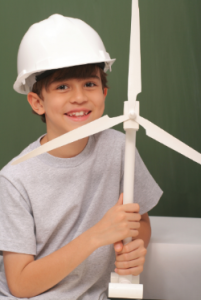
In an effort to distinguish traditional science, technology, engineering, and math (STEM) programs from those with a focus on ecology and sustainability, some educators have recently been adding “green” to STEM programs. The concept is so new that a standard definition of GreenSTEM—one that fuses the real-world connections intrinsic to STEM learning with the deeper concept of sustainability—has yet to be penned.
If “… going green means to live life, as an individual as well as a community, in a way that is friendly to the natural environment and is sustainable for the earth,” as the all-recycling-facts.com website states, then GreenSTEM programs would incorporate science content, technology tools, engineering design, and math applications into problem-based projects, which have the goals of conserving natural resources and energy; reducing pollution, consumption, and waste; and protecting the health of our ecosystems.
On a recent tour of a few Colorado Green Ribbon schools, the characteristics of GreenSTEM were evident, supporting what I know from my own GreenSTEM teaching experience. The entire school culture reflected the principles of a GreenSTEM environment, with common themes that were clearly woven throughout presentations by students, teachers, principals, and superintendents. GreenSTEM characteristics extended outward to the physical appearance of schoolrooms and grounds, and even to messages on signage and t-shirts worn by students and staff.
These themes created a mosaic image of the GreenSTEM characteristics:
- Relevant, engaging project-based learning that blends the latest best-practices in science, technology, engineering, and math;
- Student-driven sustainable projects that create innovative thinkers;
- Unique STEM projects that address each school’s unique indoor and outdoor environment, and broader community needs;
- Green job connections through pathways to business partnerships and higher education;
- Life-changing and empowering service-learning for students, teachers, parents, and community; and
- Whole-child and whole-school passion for being lifelong learners and citizen scientists.
At McREL, we are working on creating a clear, standard definition of GreenSTEM and building a GreenSTEM educator support network. One useful resource to begin the conversation is a one-page “STEM and Our Planet Infographic,” created by the National Environmental Education Foundation (NEEF).
The NEEF also provides an online resource center for GreenSTEM ideas, discussion, and support. To explore these resources, visit their “Greening STEM Learning Center.”
To learn more about GreenSTEM and follow our progress in developing tools, resources, and professional development opportunities to help educators plan for and implement GreenSTEM, follow @STEM_McREL on Twitter, or read more about it on our website.
Ready to start? Join us for a two-day workshop at McREL, “GreenSTEM: Inspiring and Empowering Learners to Change the World,” on June 11–12, 2015, to begin the process of building your own GreenSTEM program.
Contact info@mcrel.org for more information about McREL’s GreenSTEM initiative.


Since most jobs in the Green Energy field are not sustainable without massive Federal subsidies i.e. wind energy and solar energy, is focusing STEM in Green Energy really the way to go?